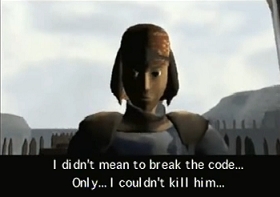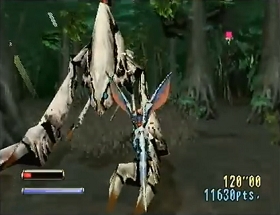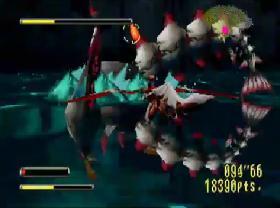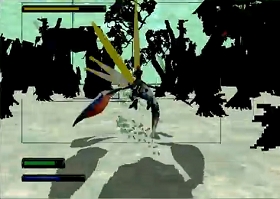Contributed By
Published
A review of Panzer Dragoon II Zwei.

The best way to describe Panzer Dragoon is to take an old-school 2D side scrolling shoot ‘em up and then imagine blasting hordes of enemies from a pilots-eye view atop a dragon in a 3D environment. Players fly on a fixed course through surreal 3D levels with a limited ability to steer, while blasting anything out of the sky that dares to stand, or in this case, fly in the way.
Panzer Dragoon Zwei is the next step in Panzer Dragoon’s evolution.
Panzer Dragoon Zwei is in fact a prequel to the popular Saturn rail shooter, Panzer Dragoon. It seems that the game began development immediately after the release of the original game. The creators, Team Andromeda, were one of the few developers who were actually able to squeeze the most out of the Saturn at the time, even teaching Sega a thing or two on how to build on the console’s strengths and not on sand.

The original Panzer Dragoon shifted vast amounts of colourful texture mapped polygons for its time, and rendered some impressive reflective water effects that rippled as they reflected the world above. Even transparent lasers were added to its list of special effects. Panzer Dragoon Zwei takes the original game to the next level. The sequel refines the graphics of the original and delivers even more special effects that the Saturn was supposedly incapable of producing. Now if you ask me, the only thing Panzer Dragoon Zwei is incapable of doing is disappointing fans of the first game.
The second game tries to redefine the label “rail shooter” that was branded to the original a bit by introducing multiple routes, and refines the basic gameplay by making everything more sharp and fluid, especially when rotating the camera. This time the dragon can not only fly but run and evolve into more powerful forms. Panzer Dragoon Zwei doesn’t build on the story of the original game. It gives the original game and the origins of the dragon the story they were missing.
The game is set in a post-apocalyptic world where humanity has been pushed to the brink of extinction by its own genetically engineered creations. Gradually, human beings are beginning to regain some of the lost power they once held and let slip through their fingers. However, the more things change the more they stay the same as nations start excavating ancient weapons to wage war on each other.

This particular story begins in a small farming village on the frontier called Elpis (which in Greek means hope) where all mutants are outlawed in case they pose a threat again. Despite being small and harmless, mutant khourieats are killed immediately for that very reason (note: khourieats are called coolias in Panzer Dragoon Saga). Khourieats are common two-legged beasts of burden, but mutations have become a regular occurrence now it seems. The ominous blue-white light glowing on the necks of the innocuous creatures elicits only fear in a world already rife with mutant predators. Lundi, the main character of this unfolding drama, makes the more cynical observation that they are more likely killed on sight because they cannot be tamed, or sold. Still, Lundi defied his village’s code to kill all mutants, by keeping such a khourieat, because it had a pair of wings. He named the creature Lagi and hid it from sight. Lundi didn’t want to break the code, but his compassion couldn’t allow Lagi to be killed. He secretly hoped that Lagi was a legendary dragon, similar to those in the stories he’d heard as a child, and that he could become its rider and help save the world.

A patch of translucent blue-white light, said to be a bad omen among his people, glows brightly on Lagi’s neck, almost vibrating with power. One year later while Lundi is riding his new dragon friend outside his village in an unsuccessful attempt to teach his now fully-grown best friend to fly, Lundi’s village is reduced to ashes by a beam of light coming from a huge rectangular skyship above. A beam of light washes over his town like a tidal wave and wipes his home from the face of existence.
Lundi is temporarily blinded by a bright white light rushing towards him from his village’s direction, and is startled to see a ship looming over the remnants of his home. The ship is so huge that it fills the sky. Lagi’s mouth opens and a ball of blue-white energy forms between his jaws, sucking in more and more energy. The ball quickly bursts into three separate arrows of light, which in turn blast towards the ship. They twist and coil in the air but fade into nothing before they reach their destination. These arrows of light, as they are described in legends, finally confirm in Lundi’s mind that Lagi is indeed a dragon of legend. Is the green light Lagi emits an ominous light like the villagers said, or their salvation? Lundi and Lagi embark on a dangerous quest for both revenge and to stop the ancient ship before it kills again.
During the time period of Panzer Dragoon Zwei the Empire is at war with another powerful nation named Meccania. Not much is made clear about this war, but the player will fly through battle zones and encounter Imperial forces, which like Lundi and Lagi, are also chasing the huge ship, but not with vengeance in mind. The war between the Empire and the Confederation of Meccania is clarified later in Panzer Dragoon Saga in case anyone was wondering. More insight into Lundi’s motivations, thoughts and feelings are provided in his journals found in Panzer Dragoon Saga as well for those who are curious. Panzer Dragoon Zwei is a sequence of events told in hindsight, as if from one such journal. Seeing the world through this character’s eyes fills a personality gap in the story left empty by the silent hero of the first game in my opinion. The game also gives us the background for the armoured blue dragon seen in Panzer Dragoon that was missing in what would eventually become a trilogy.
Contents
Graphics

Like the first game, levels range from wartorn barren wastelands where nothing will ever grow again to ancient but technologically advanced ruins stretching for miles underground. The word alien best describes the world of Panzer Dragoon; the Ancient ruins are made of futuristic metallic walls carved with power veins and they are guarded by flying metallic guardians that fire laser beams of every imaginable color.
The levels are meant to depict a dying planet shackled to a mysterious past full of technologies beyond human understanding. The dusty and mountainous gray wastes of episode 2 portray the desolate landscape with ease, while the ancient labyrinthine ruins draw the player into a deeper mystery that sparks your curiosity into wanting to know more. An “alien” world is probably the best way to describe it. The game sets up an otherworldly atmosphere that beckon players into the deeper mystery of unanswerable questions.
Team Andromeda may not have been the most prolific of games developers in the world, but their artistic vision certainly exudes originality here. Like the original game, the art direction is so distinct that it almost immortalizes itself. I especially love the armour plated monsters and the blimp-like flying warships. They are so unique that they are unforgettable. The bosses never fail to strike you as even more alien than the world they spawned from, such as the boss in episode 2 which looks like a giant skeletal monkey. It’s so huge that it almost fills the entire screen, and the way it runs on hind legs makes it look like something out of Aliens. Panzer Dragoon is known for its screen filling bosses, and the sequel maintains that tradition.
The game blends 2D backgrounds with 3D in a way that doesn’t seem out of place. Keep in mind, that if you do insist on criticizing any game, you should always judge it on its own merits for the time. And for the time, this was damned good. By those standards, Zwei couldn’t get much better.
Now Panzer Dragoon ran at a questionable 20 frames per second, which was not the smoothest frame rate in the world. Panzer Dragoon Zwei updates at a brisk 30 frames per second, however, so movement feels smoother. The 640 x 224 resolution is higher than the first game (320 x 224), which makes in-game textures seem all the more sharper. The higher resolution does a nice job of reducing blocky-ness. When a ship explodes the cloudy smoke it releases doesn’t pixelate in the least for that resolution, for example. The 3D environments seem more solid and naturally darker to fit the post-war theme of the game. Usually dark, charred and shaded to post-apocalyptic perfection. However, in episode 4 players fly under a forest canopy dense with lush trees where light creeps in through the cracks to form pillars. Now if only the Saturn was capable of true 3D transparencies, but let’s not go there. The trees are actually 2D like a few other graphical tricks the game merges together almost unbeknownst to your eyes (like the falling snow in episode 5). The sense of distance isn’t too bad either even though you will be too distracted blowing everything up to care anyway. Clipping is hardly anywhere in sight and slowdown is next to non-existent.
In-game animations do a better job than many Saturn games at holding together too; in fact, the game animations are so solid that they were used in all the cutscenes. The game’s art direction stands out as fairly colorful like I said before.

It seems that Team Andromeda squeezed the most out of the Saturn. What catches my attention the most are the reflective transparent rivers seen throughout episode 4; they bring the level to life by rippling with a strange oily fluidness almost as if the water is unnatural. The end of level boss, which is a giant mechanical fish that fires laser beams at you, dives underneath the water and is fully transparent.
I wish that other Saturn games had used all these graphical tricks. Team Andromeda made clever use of the Saturn’s VDP 2 background chip to overlay the 3D water with a 2D scaling VDP 2 plane to create the transparency. The planes are only ever flat and one-sided, apparently (similar to the transparent fire effects seen in Burning Rangers). A 2D trick perhaps, but a transparency effect nonetheless. And one that is nothing short of conspicuous I might add. Team Andromeda squeezed every last drop of power out of the Saturn and created special effects seen in few other games.
As you may have come to expect, the bosses in this game are huge and innovative. Of course, in Panzer tradition the bosses fill the screen and thus create a sense of danger. They range from the conventional human skyships with cannons pouring out of every gunport to the unconventional biomechanical slaves of a long forgotten past. Please sir, can we have some more?
Sound
Team Andromeda timed the music to reflect the pace of each situation. You could call it situation changing music. The music is a composition of synthesized sounds unlike the orchestral music of the original game, which isn’t the step backwards that you may think it is at first. The music almost sends you back in time but in the future with the strangest mixture of flowing windpipes and ever faster synthesized beats. The Panzer language is carried over from the first game, and spoken throughout this one to once again to create a sense of continuity and reinforce the world’s already alien atmosphere. As if you needed any more reminders. The sound effects range from thundering explosions, to the sounds of fleshy add metallic monsters being blown to pieces and don’t fail to sync up. Overall the sounds make you feel like you are really continuing on from the first game. Everything feels consistent in that department with no unnecessary changes to the winning formula.
Gameplay

The L and R buttons shift your point of view by 90 degree increments left or right within a 360 degree scope. These controls are far more responsive than the first game which seemed to take its time moving from one angle to the next. Mastering these controls is essential if the player wishes to survive because enemies will approach and attack from every angle. A radar in the top right corner of the screen indicates the position and number of enemies on-screen. It also indicates your current line of sight.
The dragon is always on the move and sometimes enemies will come into view, in fixed positions. Either way, action is invariably non-stop. Lagi has much maneuverability in the air but when running on the ground things become tighter, especially when facing fleets of incoming enemy ships and bio-monsters that attack from all sides at once with little room to dodge. Blasting enemies out of the sky before they have the chance to do too much damage, and intercepting enemy fire before it reaches you is the key to maintaining a full health bar. However, dodging still pays off when weapon fire cannot be cancelled out by lasers if you are fast enough.
Panzer Dragoon was a rail shooter, which meant the player was powerless to alter the route their dragon took through each level. Panzer Dragoon Zwei is still on rails, but forks in the road, located at specific points in a level, lead to different routes. They serve to reduce the linearity a bit. The switching points, a better definition, determine difficulty, method of travel (flying or on foot), as well as scenery and pace. The best example is when the canyon in episode 2 splits into two: when turning left your dragon runs to the edge of a verge, spreads its weak wings and takes flight to face fleets of flying fortresses. Turn right and your dragon fails to take flight but glides to the ground where it runs through a gated human fortress and faces a small army of cannon turrets at the end that blocks the exit. The route then joins up to face the same end level boss.

There are initially three methods of attack at the players disposal: standard laser attack, lock-on lasers, and berserk attack. Normal lasers are fired by the dragon’s rider, the man whose role you’ve assumed, and can be fired constantly. Tapping the fire button once will launch a flurry of laser blasts, so can be kept constant quite easily (unlike the first game which fired one laser blast with each tap requiring quick button bashing for a fast rate of fire). Lock-on lasers are activated by holding the attack button while moving the cursor over on-screen targets. A square cursor will remain locked onto a chosen target until the attack button is released. Your dragon then sends blue-white laser beams flying to them (called arrows of light) that will never fail to reach their destination. This type of attack is very useful indeed for more elusive targets. As your dragon becomes more powerful, you can lock onto more enemies at any given time.
The dragon’s Berserk attack unleashes hell on all enemies around you. Berserk attack basically targets any and all enemies on screen at the same time and blasts everything incessantly with lock-on lasers similar to the ones you normally use until the player’s berserk bar reaches zero. The berserk bar can be charged up simply by attacking enemies; naturally, the more berserk energy available, the longer a berserk attack will last. The screen and everything in it goes black and white while lasers fire everywhere to convey a sense of venting built up power, hence the name no doubt. Needless to say it’s quite dramatic.
Panzer Dragoon Zwei also introduces a dragon evolution system that shapes the dragon’s growth according to however well the player tackles each level. At the end of a level, the game will tally points for the number of enemies shot down, and whatever routes, if any, were taken. A 90% shot down ratio will grant the player more points than half of that amount, and will contribute a certain number of points to the tally. Gaining such points will cause your dragon to shed its skin and morph into deadlier versions of itself. The greater amount of overall points achieved at the end of each level, the greater your dragon will become. If you take the hardest routes in each level and leave nothing alive, then your dragon will morph into its most powerful form to become winged death itself.
Longevity
There are a total of seven episodes, which hardly amounts to much, yet perfecting the outcome of each level lies the game’s true charm. The game offers multiple routes, as well as the ability to morph your dragon depending on how well you play. Of course, the whole gaming experience itself is exciting enough for any 3D shooting fan to warrant many replays, and every level needs to be finished perfectly before the true ending is unlocked, or if you simply love to overcome a challenge. Completing the game once opens up a whole new host of options known in the game as Pandora’s Box. Like in the original game, new weapons are available, and the player can ride some familiar enemy dragons instead of the usual metamorphic Lagi. These are but a few examples of the options available, and some remain inaccessible until the game is completed properly.
Overall
Panzer Dragoon Zwei is without any doubt one of the best 3D shooting games available for the under-rated Sega Saturn, and one of the most visually impressive Saturn games next to Sonic R. This is one of the better looking games found on any 32-bit console nevermind only the Saturn. The game really stands out from the crowd and is deserving of at least some recognition in that respect. I recommend buying it even today just to know where this series truly began. The graphics hardly compare to Panzer Dragoon Orta of course, nor is the story even half as compelling as Saga, but soaking up the futuristic atmosphere alone still makes this trip down memory lane worth playing at least once.
- Graphics
- 9/10
- Sound
- 10/10
- Longevity
- 7/10
- Gameplay
- 9/10
- Overall
- 9/10
